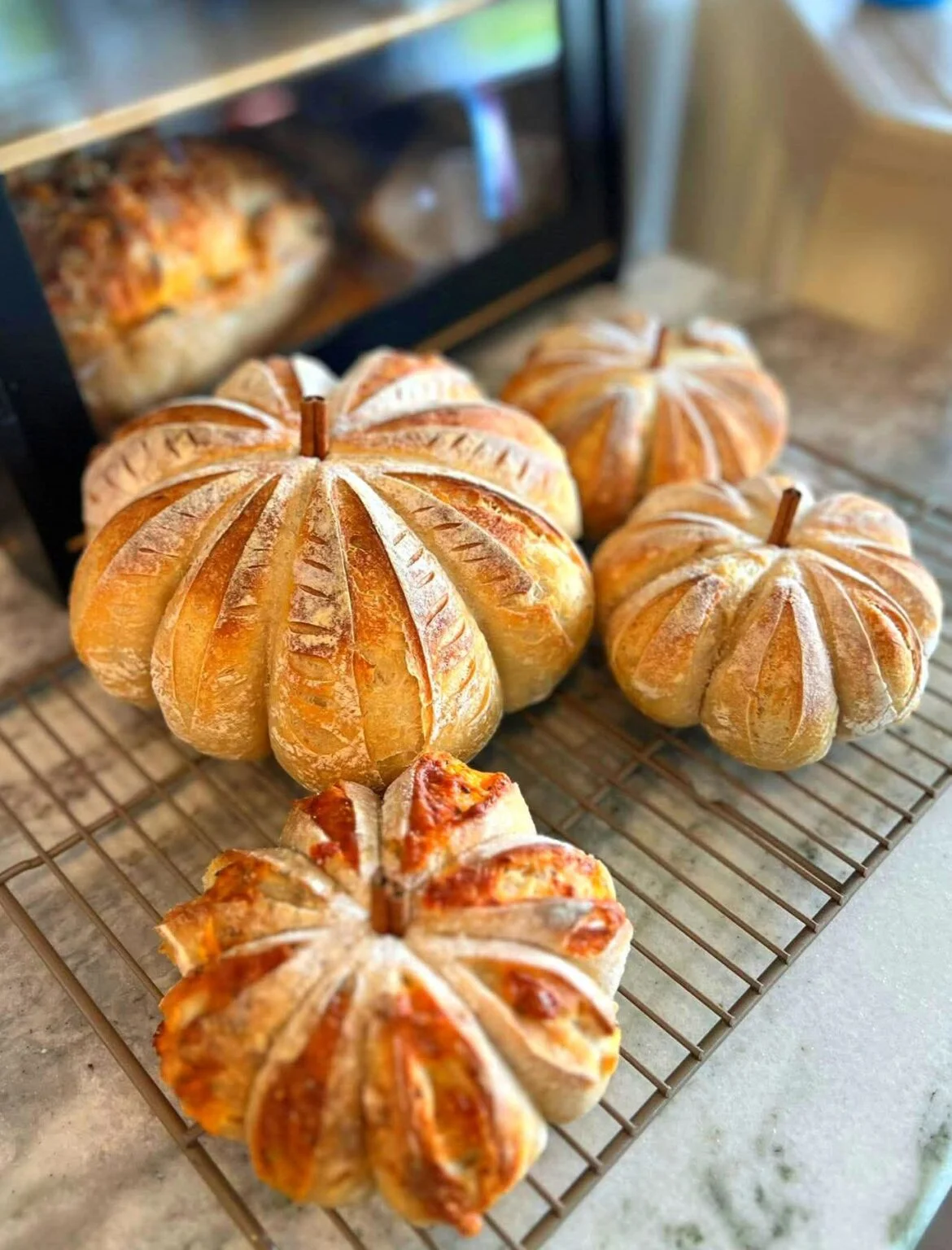Sourdough Pumpkin Bread Recipe
Baking sourdough bread is always a rewarding process, but when autumn rolls around, adding pumpkin to your sourdough gives it a seasonal warmth and subtle sweetness that makes it truly special. The natural tang of sourdough pairs beautifully with the earthy richness of pumpkin, while spices like cinnamon and nutmeg enhance the cozy fall flavors. Sourdough pumpkin bread can be enjoyed as a breakfast loaf, a sweet snack, or even served alongside savory dishes like soups and stews. This recipe combines the classic sourdough process with pumpkin purée, producing a moist, flavorful, and beautifully golden loaf.
Ingredients
For the levain (starter build):
-
50 g active sourdough starter
-
50 g all-purpose flour
-
50 g water (room temperature)
For the dough:
-
400 g bread flour
-
100 g whole wheat flour
-
250 g pumpkin purée (unsweetened, canned or homemade)
-
150 g water (adjust as needed)
-
10 g salt
-
50 g honey or brown sugar (optional, for sweetness)
-
1 tsp ground cinnamon
-
½ tsp ground nutmeg
-
½ tsp ground ginger
-
¼ tsp ground cloves
-
30 g olive oil or melted butter
Optional toppings:
-
Pumpkin seeds (pepitas) for garnish
-
Rolled oats for extra texture
Step-by-Step Instructions
1. Build the levain
The night before baking, feed your sourdough starter to create a levain. Mix 50 g starter with 50 g flour and 50 g water in a jar or bowl. Cover loosely and let it sit at room temperature overnight until bubbly and doubled in size.
2. Mix the dough
In a large mixing bowl, combine the levain with pumpkin purée, water, honey or sugar (if using), and oil or butter. Stir until the levain dissolves. Add the flours, spices, and salt. Mix with a spoon or dough scraper until all flour is hydrated and you have a shaggy dough.
3. Autolyse and rest
Cover the bowl with a damp towel and let the dough rest for 30 minutes. This resting period allows the flour to absorb moisture and gluten to begin developing naturally.
4. Knead or stretch and fold
After resting, perform a series of stretch-and-folds in the bowl. With damp hands, grab one side of the dough, stretch it upward, and fold it over the center. Rotate the bowl and repeat 3–4 times. Let the dough rest for 30 minutes, then repeat this process 3–4 times over the next 2 hours. This builds gluten strength while keeping the dough soft and airy.
5. Bulk fermentation
Cover the dough and let it rise at room temperature for 4–6 hours, or until it has risen about 50% in volume and shows bubbles along the surface. Because pumpkin adds moisture and density, the rise may be slower than a standard sourdough. Be patient and let fermentation do its work.
6. Shape the loaf
Turn the dough out onto a lightly floured surface. Shape it into a round boule or an oval batard, depending on your baking vessel. Place the shaped dough seam-side up in a floured banneton or bowl lined with a towel.
7. Cold proof
Cover the dough and refrigerate it overnight, or for at least 8–12 hours. This slow proofing enhances the flavor, strengthens the crust, and makes scoring easier before baking.
8. Preheat oven and prepare
The next day, preheat your oven to 475°F (245°C) with a Dutch oven inside for at least 30 minutes. Remove your dough from the fridge. Gently invert it onto parchment paper, seam-side down. Score the top with a sharp razor or lame to allow expansion. Optionally, sprinkle pumpkin seeds or oats on top for decoration.
9. Bake the bread
Carefully place the dough into the hot Dutch oven. Cover with the lid and bake for 20 minutes. Remove the lid, lower the temperature to 450°F (230°C), and bake another 20–25 minutes until the crust is deep golden brown and the loaf sounds hollow when tapped.
10. Cool and enjoy
Remove the bread from the oven and let it cool on a wire rack for at least an hour before slicing. This allows the crumb to set and the flavors to fully develop. Serve slices warm with butter, cream cheese, or even a drizzle of honey.
Tips for Success
-
Pumpkin moisture: Pumpkin purée can vary in water content. If your dough feels too wet, add a little more flour during mixing. If it feels too dry, increase the water slightly.
-
Starter activity: A strong, active starter is essential. If your dough seems sluggish, give your starter a few extra feedings before baking day.
-
Spice balance: Adjust the spice mix to your taste. For a sweeter bread, add extra cinnamon or a dash of vanilla extract. For a savory loaf, reduce the spices and add rosemary or sage instead.
-
Serving ideas: This bread pairs beautifully with fall soups like butternut squash, chili, or tomato basil. It also makes a fantastic base for French toast.
Final Thoughts
Sourdough pumpkin bread is more than just a seasonal twist—it’s a loaf that embodies the comforting flavors of autumn while showcasing the natural fermentation process of sourdough baking. With its golden hue, tender crumb, and warm spicing, it’s equally at home on a festive holiday table as it is in your breakfast routine. The process may take some time and patience, but the result is a loaf filled with flavor, texture, and heartwarming aroma. Once you try it, you’ll find yourself baking this bread not only in the fall but all year round whenever you crave a little cozy comfort in your kitchen.


